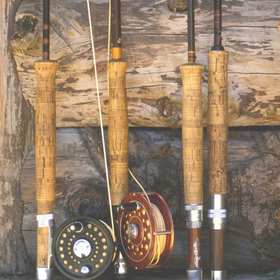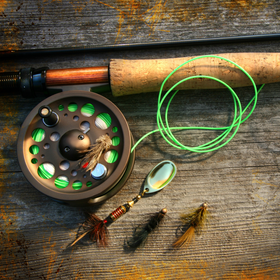Like all bass fishing, bass fly fishing has exploded in popularity. The largemouth bass is considered by many the greatest of all gamefish. Once limited to just the Eastern United States, the largemouth bass has been introduced all over the continent. When most people think of bass fishing they think of, stiff fiberglass rods, heavy lines and large lures. But more and more fisherman are finding the advantage of fly fishing for this game fish.
Advantages of fly fishing:
Fly fishing allows the angler a wider variety of food imitations. While large lures only imitate a small number of food sources, flies can imitate virtually all the sources of bass food, including small organisms like nymphs and even dry flies. Fly fisherman can also cast out mice, frog, and a variety of other food sources for these opportunistic feeders. Many times bass are found in shallow water, hiding under or near logs or snags or in weeds. Fly casters have the advantage of more accurate placement, and being able to place their offering quietly without spooking skittish fish.
Bassy Water:
Largemouths usually emerge in early spring albeit a bit sluggish, but nevertheless with a speeding up metabolism, they are seeking food. Most largemouth’s will seek food in the shallows, being territorial the best hiding places will go to the biggest fish. Recognizing a good bass hiding spot is the first step in successful bass fishing. Fallen logs or weedy areas will provide cover for the wary lunker. Often times bass can be spotted by the careful observer, in clear water bass will appear green to pale olive across the back and white to pale yellow in the belly. In some areas a partner system will be beneficial with one angler standing above the water to provide a bird’s eye view. Float tubes can also be helpful allowing an angler to cover a lot of water in shorter amount of time, although you give up some of the advantages of sight angling.
When to Fish:
Largemouth Bass emerge in the early spring from deeper water. The exact timing depends on the region and the severity of the winter. But when ice begins to thaw and the water warms up, the largemouths metabolism begins to quicken albeit slowly at first. The strikes won’t be as hard, as the reticent fish, slurp in minnow patterns. Much like a trout slurps up an emerger pattern.
But once the water begins to warm to 60 degrees. The largemouth’s thoughts turn to spawning. In many areas this is around April. And the bass feed furiously, and seemingly without much thought to selection. It is during this time, that the bass fly fisher can found in their true natural environs. Bass cruising the shoreline in 1-3 feet of water, needing to bulk up for the upcoming spawn. It is then that the bass are the easiest to catch. Being fiercely territorial and in a feeding frenzy, they will attack anything in their path with a ferocity that makes this fish legendary.
After the spawn the bass seeks out deeper water, however, early morning and evening in particular can give one great action all summer long. And with the cooler waters of fall, bass return to activity that makes a trip to your favorite bass whole a worthy endeavor.
Techniques:
Early in the morning, I usually fish the banks with steamers. Casting out Woolly Buggers, Woolly Worms, Muddler Minnows, and even a leech pattern or two. One to three feet of water is where I concentrate, while the bass cruise actively looking for fish to eat.
In the spring time by afternoon I have switched to floating bass bugs. The very thing that makes bass fly fishing so fun. Casting one toward a nice looking bass hiding spot, I allow it to sit there for a few seconds. If you allowed the fly to ‘pop’ upon landing and have a nice bass picked out, often times this all that is needed for the bucketmouth to inhale your offering. Make sure your rod tip is at the proper angle to absorb the hit, or the game will be over before it begins.
If after a few seconds the ‘hit’ doesn’t occur, begin retrieving your fly at intermittent intervals like would occur in nature. This ‘popping’ action is what attracts the bass to your offering. Watch for the wake as the great hunter is not at all shy, and remember especially trout anglers, the bass’s mouth is huge and these animals were built for eating.
Flies:
Well, The Big Y Fly Co. is about selling flies, so you didn’t think we would forget that did you. If it is still unclear bass are opportunistic carnivores with huge mouths, that will eat anything. There are the usual bass bugs that float like the Frog, and the Mouse Rat. Then there are the divers, that float and then sink when you retrieve them, like the Dahlberg divers. And then there are the streamers, like the Woolly Buggers, Clouser minnows. Furthermore for those hot days or big reservoirs, there are sculpins and leeches, that like bass will seek deep water.
The great Largemouth Bass has soared in popularity like few other game fish. If you haven’t ever experienced fighting one of these, you are missing out on something special. Now introduced virtually everywhere throughout the continent on North America, there bound to be some great bass fishing not for from your door.




